
The Family Computer Disk System, commonly shortened to the Famicom Disk System or just Disk System, is a peripheral for Nintendo's Family Computer home video game console, released only in Japan on February 21, 1986. It uses proprietary floppy disks called "Disk Cards" for cheaper data storage and it adds a new high-fidelity sound channel for supporting Disk System games.

Koji Kondo is a Japanese music composer, pianist, and sound director for the video game company Nintendo. He is best known for his many contributions to the Super Mario and The Legend of Zelda series of video games, among others produced by the company. Kondo was hired by Nintendo in 1984, becoming the first person hired by them to specialize in video game music. His work in the Mario and Zelda series have been cited as the most memorable in video games, such as the Super Mario Bros. overworld theme.

Rayxanber is a 1990 scrolling shooter video game developed and published by Data West for the FM Towns. It is the first entry in the Rayxanber series, followed by Rayxanber II (1991) and Rayxanber III (1992) for the PC Engine platform. In the game, the player assumes the role of a fighter pilot from Earth controlling the RT-X-32 space craft to fight against the biomechanical Zoul Empire. The title was created by Team 50, a group within Data West. The soundtrack was scored by Yasuhito Saito, who composed for other titles such as Layla and The 4th Unit series. It garnered mixed reception from critics.
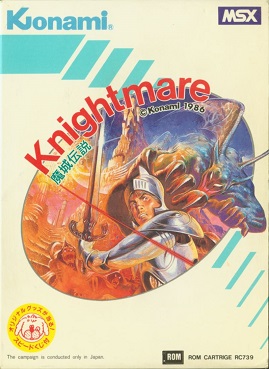
Knightmare is a 1986 vertically scrolling shooter video game developed and published by Konami for the MSX home computer. It was included in compilations for the MSX, PlayStation and Sega Saturn, followed by a port for mobile phones, and digital re-releases for the Virtual Console and Microsoft Windows. It is the first entry in the Knightmare trilogy. The game stars Popolon, a warrior who embarks on a quest to rescue the princess Aphrodite from the evil priest Hudnos. The player must fight waves of enemies while avoiding collision with their projectiles and obstacles along the way, and facing against bosses.

Blood Bros. is a 1990 arcade game developed and published by TAD Corporation in Japan and Europe, and later published in North America by Fabtek. It is a spiritual sequel to the 1988 game Cabal, with almost identical mechanics. A bootleg of Blood Bros. is known as West Story.
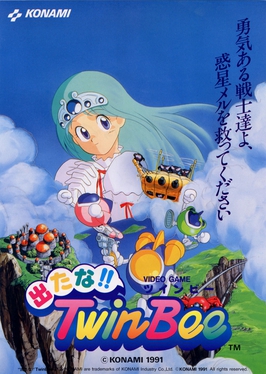
Detana!! TwinBee, released in Europe and North America as Bells & Whistles, is a 1991 vertically scrolling shooter arcade video game developed and released by Konami. It is the fifth entry in the TwinBee series and the second to be released for arcades following the original TwinBee. Set several years after the events of TwinBee, players assume the role of Light and Pastel taking control of TwinBee and WinBee to defeat invading forces of the evil alien Iva and save planet Meru after receiving an SOS message sent by Princess Melora.

Xexex, released as Orius in North America, is a 1991 side-scrolling shoot 'em up arcade game by Konami. It draws on Irem's R-Type and Konami's other shoot 'em up Gradius, while adding the tentacle mechanics of Irem's other shoot 'em up XMultiply. In the game, players take control of the Flintlock space fighter in a mission to rescue Princess Irene La Tias of Planet E-Square, who has been captured by the evil galactic warlord Klaus Pachelbel.

Metal Slader Glory is an adventure game developed and published by HAL Laboratory for the Famicom in 1991. The game is set in 2062 after humans have colonized the Moon and established several space stations. Earth-based mechanic Tadashi and his girlfriend discover a mech from a war eight years past with an ominous message stored in its memory suggesting Earth is in danger. Tadashi decides to venture to nearby space colonies along with Elina and his younger sister Azusa to investigate the origins of the mech. As Tadashi, the player speaks with other characters and picks dialogue and action commands to advance the narrative.
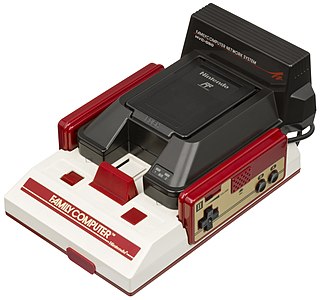
The Family Computer Network System, also known as the Famicom Net System and Famicom Modem, is a peripheral for Nintendo's Family Computer video game console, and was released in September 1988 only in Japan. Predating the modern Internet, its proprietary dial-up information service accessed live stock trades, video game cheats, jokes, weather forecasts, betting on horse racing, and a small amount of downloadable content. The device uses a ROM card storage format, reminiscent to the HuCard for the TurboGrafx-16 and the Sega Card for the Master System.

The Nintendo Entertainment System (NES) is an 8-bit third-generation home video game console produced by Nintendo. It was first released in Japan in 1983 as the Family Computer (FC), commonly referred to as Famicom. It was redesigned to become the NES, which was released in American test markets on October 18, 1985, and was soon fully launched in North America and other regions.

Finalizer - Super Transformation is a vertically scrolling shooter released in arcades by Konami in 1985. The player controls a jet flying through several different states in America shooting different enemies.
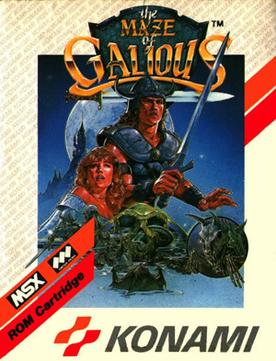
The Maze of Galious is a 1987 platform-adventure video game developed and published by Konami for the MSX home computer. A reworked conversion was released for the Family Computer. Both versions were re-released digitally for Microsoft Windows. The second entry in the Knightmare trilogy, it follows the respective hero and former damsel in distress of the previous game, Popolon and Aphrodite, as they embark on a journey through Castle Greek to free their unborn child Pampas from the evil priest Galious. The player explores each map in search for items and power-ups to progress, while also fighting enemies and bosses.

Castlevania, known in Japan as Akumajō Dracula, is a 1986 platform game developed and published by Konami for the Family Computer Disk System. It was originally released in Japan in September 1986, before being ported to cartridge format and released in North America for the Nintendo Entertainment System (NES) in May 1987 and in Europe in 1988. It was also re-issued for the Family Computer in cartridge format in 1993. It is the first game in Konami's Castlevania video game series.
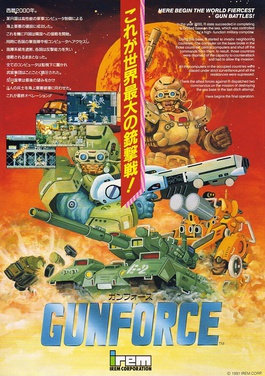
GunForce is a side-scrolling run and gun video game produced by Irem for arcades in 1991. The game was ported by Bits Studios and published by Irem for the Super Nintendo Entertainment System in 1992. The sequel, GunForce II, was originally known in Japan as Geo Storm.

Major Title is a golf sports video game that was released by Irem to arcades in 1990. A version of the game for the Super Nintendo Entertainment System as well as an arcade sequel, Major Title 2: Tournament Leader, were released in 1992. The SNES game and the arcade sequel were released in the United States as The Irem Skins Game.

Cho Ren Sha 68K is a 1995 vertically scrolling dōjin shoot 'em up video game developed and originally published by Koichi "Famibe No Yosshin" Yoshida at Comiket for the X68000. Taking place in a ring structure, players take control of a space fighter craft to fight against an assortment of enemies and bosses.
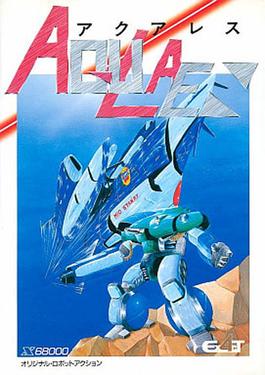
Aquales is an action role-playing run and gun video game developed and published by Exact exclusively for the X68000 in Japan on September 12, 1991. The second title to be created and released by Exact for the X68000 platform, the game takes place in the dystopian future of 2069 where the British Elias-Rits Investigative Unit ship went missing during a reconnaissance operation at the Kermadec Islands, as players assume the role of American pilot Fredric von Nyuya from the elite World-Ocean Development League squad taking control of a mecha in an attempt to unveil the truth behind the mysterious disappearance of the Elias-Rits embarkation during their operation. Its gameplay mainly consists of action and shooting mixed with mission-based exploration, as well as role-playing elements, using a main two-button configuration.

Ghox is an action arcade video game developed by Toaplan and published by Taito in Japan and Europe in November 1991. It is notable for being one of the few titles by Toaplan that has not received any official port to home consoles as of date. Taking place in a fantasy world where the evil magician known as Jagula sealed the goddess Lucia in the netherworld, players assume the role of Axis and Bilious in an effort to defeat both Jagula and the unleashed evil spirits from the netherworld. As of 2019, the rights to the game are owned by Tatsujin, a company founded in 2017 by former Toaplan member Masahiro Yuge and now-affiliate of Japanese arcade manufacturer exA-Arcadia alongside many other IPs from the defunct studio.

The Nintendo Entertainment System (NES), an 8-bit third-generation home video game console produced by Nintendo, had numerous model variants produced throughout its lifetime. It was originally released in 1983 as the Family Computer in Japan, with design work led by Masayuki Uemura. Nintendo intentionally redesigned it as the NES in North America in an attempt to avoid the stigma of video game consoles lingering from the video game crash the same year; while it was initially conceptualized as a home computer, it was ultimately modeled after a videocassette recorder (VCR) for its debut there in 1985. Nintendo subsequently exported the NES to Europe and Oceania via local distributors.
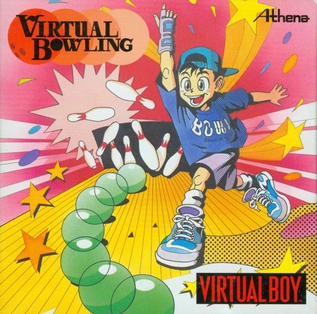
Virtual Bowling is a 1995 sports video game developed and published by Athena in Japan for the Virtual Boy. In the game, the player participates in a series of bowling tournaments consisting of four 10-frame matches at various alleys against computer-controlled opponents, in order to obtain a high score and progress further. Its gameplay, featuring three modes of play, is viewed from a first-person perspective.





















